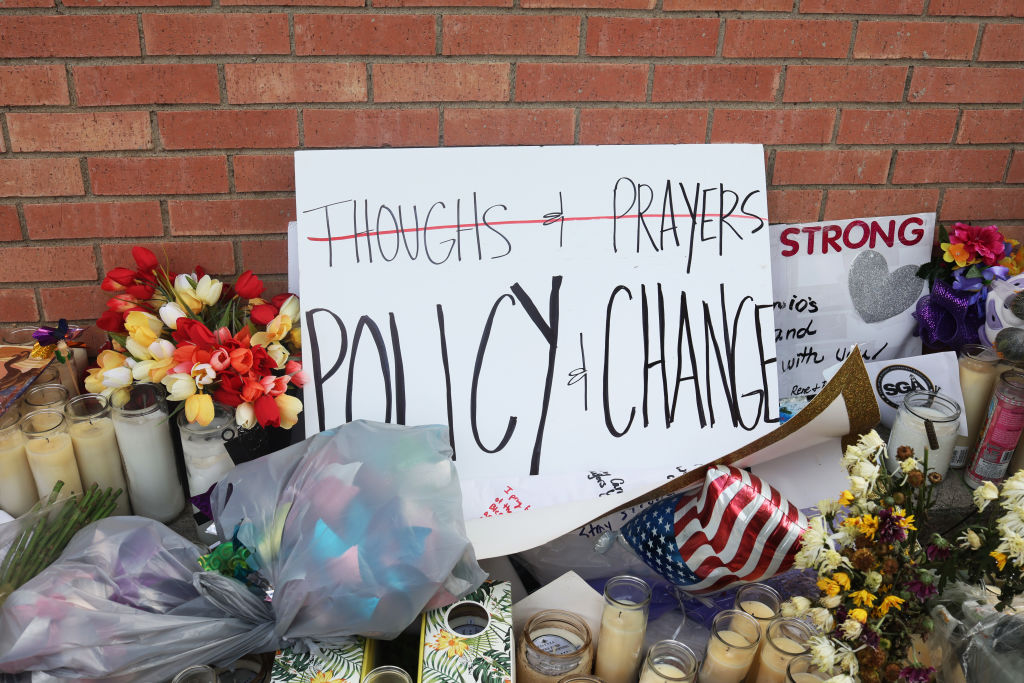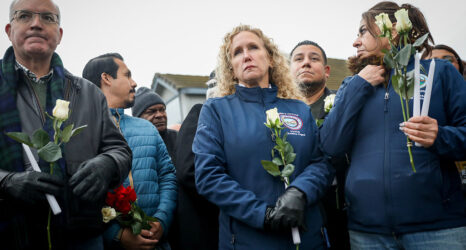Firearms are the leading cause of death among children ages 1-19 in the United States. An armed officer is a last resort. It is time to be proactive.

The U.S. just mourned the one-year anniversary of the Robb Elementary School shooting in Uvalde, Texas, where 19 children and two teachers were killed, and 15 more children wounded. Despite multiple armed guards on campus at the time of the shooting, and 376 law enforcement officers eventually descending upon the school, no one was able to stop the gunman. How did the state of Texas respond to public cries demanding school safety? With House Bill 3, currently awaiting Gov. Greg Abbott’s signature, which would require an armed officer on every school campus.
On the national level, Sen. Rick Scott (R-Fla.) recently introduced the School Guardian Act, which proposes funding for an armed officer in every school from kindergarten through 12th grade in this country.
More guns on campuses won’t make people safer, researchers say. These campus-carry laws highlight our elected officials’ inability to keep children safe—which is a core tenant of reproductive justice.
Founded in 1994 by the efforts of 12 Black women, reproductive justice is “the human right to maintain personal bodily autonomy, have children, not have children, and parent the children we have in safe and sustainable communities,” as defined by SisterSong. The reproductive justice movement positions reproductive rights and health within the larger context of families and communities. The fight for reproductive justice, to keep children and all individuals safe, is inextricably linked to the urgent fight to end gun violence.
Gun violence is the leading cause of death for children and teens ages 1-19, and young adults under the age of 25, according to a new report from Johns Hopkins University analyzing 2021 data from the CDC.
Just this year, there have been 19,280 deaths in the U.S. related to gun violence, with 291 mass shootings and 113 children under 11 years old killed by gun violence, the Gun Violence Archives reports.
For many of us, it is personal. I was 9 years old, completing homework at the kitchen table, while my mom both cooked dinner and watched the nightly news. I saw footage of students running from their school, hands in the air, terrified. It was 1999. In the end, the two teen shooters killed one teacher and 12 students at Columbine High School, and wounded 21 others—at the time, the worst school shooting in U.S. history.
Later that year, in my third-grade classroom in San Antonio, Texas, I participated in my first of many school lockdown drills.
Twenty-four years later, I still remember the code word that would be shared on the school intercom to initiate the lockdown. We were instructed to sit out of sight of the door window, and if necessary, our teacher would help us, one by one, out the window.
Not much has changed. House Bill 3, if signed into law by Abbott, would require each school to have an armed officer, marshal or school district employee on campus. At Robb Elementary in Uvalde, school police officers are receiving new active shooter trainings starting this month.
In Maine recently, lawmakers voted against a proposal to fund armed security guards in government-run schools.
The idea of armed officers on campuses is not a new one for many.
More Black and Latino students are arrested in public schools with officers than white students, even though they make up a smaller percentage of the overall student enrollment. Early entry into the justice system can lead to major disruptions in the educational process and for some, solidify the school to prison pipeline.
To be clear, Black students do not misbehave more than their white peers; racial bias within the school system leads to harsher punishment toward Black students.
The most consistent and powerful predictor of violent behavior is a history of violent behavior.
As a teenager, I remember my high school was heavily policed. And today, as a mother, I understand the urgency to ensure every child’s safety and wellbeing—so I understand the seeming appeal of armed officers at every school. The “out-shoot the shooter” approach brings comfort to some knowing immediate action is possible.
But this rationale is solely reactive and can be trauma-inducing for the overwhelming majority of students who may already experience bias from faculty and administrators. It is crucial for policymakers, school administrators, parents, teachers, law enforcement and representatives to decide on solutions for what is possible if stakeholders do to not want or need an armed officer at every school. Firearms are the leading cause of death among children ages 1-19 in the United States. An armed officer is a last resort. It is time to be proactive.
By centering a reproductive justice approach, it is possible to establish safe and supportive communities to raise children with proactive systems and initiatives. Young men perpetrate the vast majority of gun violence, and early evidence suggests a change in social norms and behaviors around masculinity may reduce violent behavior. Mental health is not an indication or predictor of violence—and for the majority of persons, mental health treatment can often prevent potential gun violence. The most consistent and powerful predictor of violent behavior is a history of violent behavior.
As my husband and I consider our son’s academic future and safety, our right to raise our son in a safe and supportive community has been stolen from us. Without proactive measures to reduce gun violence, it seems a day at the mall, school, grocery store or church can lead to a mass shooting.
The reduction of mass gun violence in all arenas is going to take intervention on all levels, including:
- policy, like the prohibition of guns for groups offenders of domestic violence and violent misdemeanors, background checks;
- community, especially supporting parents in raising emotionally healthy children;
- early violent behavior intervention; and
- a change in social norms related to gun culture and violence.
Just as the reproductive justice movement advocates, it is time to respect and ensure the personal autonomy and human right of personal safety for all.
Up next:





